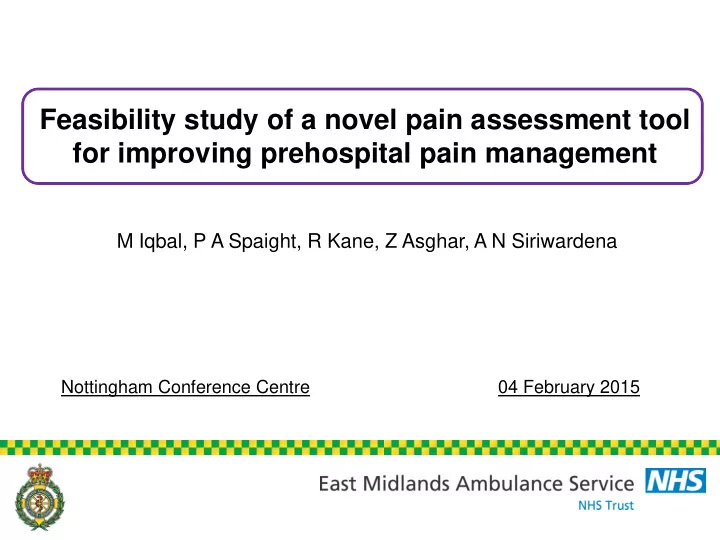

Feasibility study of a novel pain assessment tool for improving prehospital pain management M Iqbal, P A Spaight, R Kane, Z Asghar, A N Siriwardena Nottingham Conference Centre 04 February 2015
Background Pain - common Poorly assessed Outcomes affected Previous research
Study aims To develop and test a novel pain assessment tool the Patient Reported Outcome Measure for Pain Treatment (PROMPT) To determine feasibility, reliability and validity of the PROMPT
Pilot study Development of Expert panel Non-randomised the new tool review (content control group study - feasibility - to evaluate effectiveness and face validity ) (PROMPT) of using the tool
Development of the tool Secondary Analysis – qualitative data Literature review Preliminary study: • Pain and pain management • Outcome measures Qualitative data - Focus Groups (5), Interviews(28) • Development / validation tool thematic content analysis Patient Reported Outcome Measure for Pain Treatment (PROMPT)
Patient and practitioner Reported Outcome Measure for Pain Treatment (PROMPT)
Expert panel review - EMAS Clinicians – experience and Panel member length of service > 5 years selected Review Pack - sent - PROMPT, review form (18 EMAS clinicians) Reply received - 10 Analysis – Decision Face validity Findings - Items confirmation Content validity include / exclude
Expert panel review findings 1 Section A – appropriateness , practical , clarity , ambiguity, layout and workable state of the tool
Expert panel review findings 2 • Lawshe’s Content Validity Ratio (CVR) Methodology n e - N/2 n e = number of panel members rating an item - “essential” • Formula CVR = ---------------- N = total number of panel members N/2 - CVR closer to +1 item more essential - CVR closer to -1 more non-essential • CVR - all items close to (+)1 except PS by clinician’s rating weak (-0.4)
Patient Reported Outcome Measure for Pain Treatment (PROMPT)
Pilot study • Aim - to determine the feasibility, reliability and validity of the PROMPT S ettings : East (Lincolnshire) Division of EMAS • • Participant and recruitment - EMAS paramedics : emails & memos - 36 paramedics expressed interest - 20 paramedics – took part in orientation training • Orientation training
N N N N East (Lincolnshire) Division E - East area W W E W - West area W N - North area E E S - South area W E S S S S
Data collection and analysis • Pilot data - 18 paramedics – finally participated - 146 completed data forms - 132 had electronic data • Baseline data - 3 months routine clinical data (from electronic records) • Analysis - data entered in SPSS for analysis (comparing change in pain score and use of analgesic using regression)
Results • Cronbach’s alpha >0.8 • Spearman’s correlation 0.81 before and 0.83 after treatment given for pain
Table 1 Patient characteristics in pilot study compared with baseline Baseline Pilot study Chi square N=1776 N=132 N % N % Variables Age up to 20 49 (2.8) 6 (4.5) P=0.24 21 to 40 259 (14.6) 17 (12.9) 41 to 60 394 (22.2) 37 (28.0) 61 to 80 562 (31.6) 44 (33.3) over 80 495 (27.9) 28 (21.2) Sex Male 885 (49.8) 56 (42.4) P=0.10 Clinical conditions Chest pain 732 (41.2) 73 (55.3) P=0.002 Injury/Trauma 1044 (58.8) 59 (44.7) * Totals are less than 100% due to missing data
Table 2 Analgesics use comparing pilot with baseline Baseline Pilot study P * (N=1776) (N=132) N % N % Analgesic 574 (32.3) 85 (64.4 ) <0.001 Morphine 353 (19.9) 51 (38.6) Entonox 262 (14.8) 42 (31.8) Paracetamol 74 (4.2) 25 (18.9) * Taking into account age, sex and clinical condition
Table 3 Outcome of pain score following intervention for pain management comparing pilot with baseline Baseline Pilot study P * N=1776 N=132 N % N % Change in pain score Decreased 614 (34.6) 113 (85.6) Increased 54 (3.0) 1 (0.7) P<0.001 No change 531 (29.9) 18 (13.6) *Totals are less than 100% due to missing data * Taking into account age, sex and clinical condition
Conclusions PROMPT : reliable and feasible with content and predictive validity Next steps Non-randomised control group study investigating effectiveness PROMPT compared with TAU in reduction of pain in people presenting with chest pain or injury/trauma
Acknowledgements Patient and Paramedic – participants Panel members , Clinical Quality Managers, Team Leaders - EMAS References: 1 Joint Royal Colleges Ambulance Liaison Committee, Ambulance Service Association. UK Ambulance Service Clinical Practice Guidelines. London: Ambulance Service Association, 2006 2 McLean SA, Maio RF, Domeier RM. The epidemiology of pain in the prehospital setting. Prehosp Emerg Care 2002;6: 402-405 3 Siriwardena AN, Shaw D, Bouliotis G. Exploratory cross sectional study of factors associated with prehospital management of pain. J Eval Clin Pract 2010 4 Wilson FR, Pan W and Schumsky DA. Recalculation of the Critical Values for Lawshe’s Content Validity Ratio: Measurement and Evaluation in Counseling and Development 2012 45: 197 originally published online 14 March THANK YOU!
Recommend
More recommend